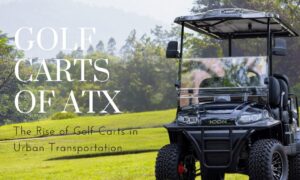Introduction
Golf carts are a common sight on golf courses, but their utility extends far beyond the fairways. These compact vehicles have become indispensable for a variety of applications, offering convenience, efficiency, and sustainability in various settings. In this article, we’ll explore the goodness of golf carts, examining their versatility and impact in the world of transportation, recreation, and sustainability as per Prosportshack.com.
The Evolution of Golf Carts
Golf carts, originally designed for transporting golfers and their equipment around the golf course, have come a long way since their inception. Here’s a brief overview of their evolution:
- Early Days: The first golf cart, known as the “Golfmobile,” was introduced in 1932. These early models were rudimentary, powered by gasoline engines, and lacked many of the features seen in modern golf carts.
- Electric Power: The transition from gasoline to electric power was a significant step in the evolution of golf carts. Electric golf carts offered quieter operation, zero emissions, and improved efficiency. They quickly gained popularity on golf courses.
- Advanced Features: Modern golf carts are equipped with advanced features, including comfortable seating, enhanced suspension systems, GPS navigation, and entertainment systems. These features make them more versatile and appealing for various applications.
Versatility Beyond the Golf Course
Golf carts have expanded their reach and usefulness beyond the golf course. Here are some of the diverse applications where golf carts play a crucial role:
- Residential Communities: Many gated communities, retirement villages, and residential neighborhoods utilize golf carts as a primary means of transportation. They offer an eco-friendly and quiet alternative to traditional vehicles for short trips within the community.
- Resorts and Theme Parks: Resorts and theme parks often use golf carts for guest transportation within their expansive properties. They provide a convenient and enjoyable way for guests to navigate large areas.
- Campuses: Universities and college campuses employ golf carts for campus transportation services. These vehicles facilitate quick and efficient movement across sprawling campuses and are especially useful for individuals with mobility challenges.
- Security and Law Enforcement: Security personnel at airports, industrial facilities, and large events often rely on golf carts for patrolling and quick response. Their quiet operation and maneuverability make them ideal for such purposes.
- Agriculture and Industry: In agriculture, golf carts are used for tasks like crop inspection, transportation of small loads, and maintaining large properties. They are also employed in warehouses and factories for moving goods and personnel efficiently.
- Sustainability: Golf carts align with sustainability efforts by offering an eco-friendly mode of transportation. Electric models produce zero emissions and consume less energy than traditional vehicles, contributing to reduced environmental impact.
Efficiency and Economic Benefits
The efficiency of golf carts is one of their standout qualities. Here’s how they offer economic benefits in various contexts:
- Energy Efficiency: Electric golf carts are highly energy-efficient, making them cost-effective to operate. They are much more affordable to maintain and recharge than traditional gas-powered vehicles.
- Reduced Operating Costs: Golf carts have fewer components than standard automobiles, resulting in lower maintenance costs. They are also exempt from some vehicle-related expenses like gasoline and emissions testing.
- Lower Environmental Impact: Electric golf carts produce zero tailpipe emissions, reducing air pollution and greenhouse gas emissions. Their contribution to sustainability aligns with the growing awareness of environmental concerns.
- Cost Savings in Communities: In residential communities, using golf carts for short trips reduces wear and tear on traditional vehicles, resulting in lower maintenance costs. Communities often have reduced road infrastructure expenses as well.
- Enhanced Productivity: In industrial and agricultural settings, golf carts help improve productivity by providing a versatile mode of transportation for workers and equipment.
Safety and Regulations
Safety is a paramount consideration in the use of golf carts, and regulations vary depending on the application and location. To ensure the safe operation of golf carts, the following measures are commonly implemented:
- Safety Features: Modern golf carts are equipped with safety features such as headlights, brake lights, turn signals, seatbelts, and rearview mirrors to enhance visibility and passenger safety.
- Speed Limitations: Speed limits are typically enforced for golf carts, especially in residential areas or on campuses, to prevent accidents and ensure pedestrian safety.
- Licensing and Age Requirements: In some regions, operators may be required to obtain a special license or permit to drive a golf cart on public roads. Age restrictions may also apply.
- Designated Paths: In many communities, designated pathways and roads are provided for golf cart travel, separating them from regular vehicular traffic.
Conclusion
Golf carts have evolved from humble beginnings as golf course vehicles to versatile and eco-friendly modes of transportation in various settings. Their impact extends beyond convenience and efficiency, encompassing economic benefits, sustainability, and safety.
As the world continues to prioritize sustainability and seek alternatives to traditional gasoline-powered vehicles, golf carts play a vital role in reducing emissions and contributing to a cleaner environment. Their versatility, efficiency, and affordability make them a valuable asset in residential communities, resorts, campuses, and various industries.
In embracing golf carts as a practical and sustainable means of transportation, communities and businesses are not only enhancing efficiency but also demonstrating a commitment to a greener and more eco-conscious future. The goodness of golf carts lies not only in their convenience but also in their potential to shape a more sustainable and efficient world.



































